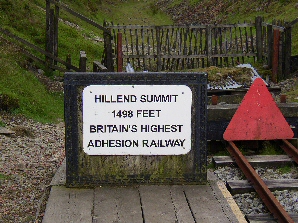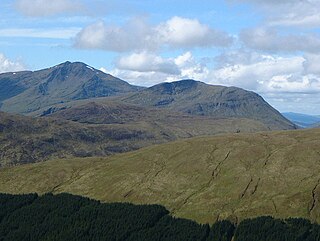Related Research Articles
James Stirling was a Scottish mathematician. He was nicknamed "The Venetian".

Allan Ramsay was a Scottish poet, playwright, publisher, librarian, and impresario of early Enlightenment Edinburgh.

Tyndrum is a small village in Scotland. Its Gaelic name translates as "the house on the ridge". It lies in Strathfillan, at the southern edge of Rannoch Moor.

Leadhills, originally settled for the accommodation of miners, is a village in South Lanarkshire, Scotland, 5+3⁄4 miles (9.3 km) WSW of Elvanfoot. The population in 1901 was 835. It was originally known as Waterhead.

Wanlockhead is a village in Dumfries and Galloway, Scotland, nestling in the Lowther Hills and 1 mile south of Leadhills at the head of the Mennock Pass, which forms part of the Southern Uplands. It is Scotland's highest village, at an elevation of around 466.6 m (1,531 ft), and can be accessed via the B797, which connects it to the A76 near Sanquhar and the A74(M) motorway at Abington.
The mines of the West Coast of Tasmania have a rich historical heritage as well as an important mineralogical value in containing or having had found, specimens of rare and unusual minerals. Also, the various mining fields have important roles in the understanding of the mineralization of the Mount Read Volcanics, and the occurrence of economic minerals.

The Royal Mines Act 1424 was an act of the Parliament of Scotland stating that gold and silver mines containing ore above a certain value would belong to the king.
The Leadhills and Wanlockhead Light Railway was a short branch railway built in Scotland to serve mining settlements, high in the Lowther Hills, connecting them to the Carlisle - Carstairs main line. The line was opened in 1901 - 1902, and was the highest standard gauge railway line in the British Isles. Hoped-for developments did not emerge, and when the world lead price slumped in the 1920s, the line sustained heavy losses. It was closed on 2 January 1939.

Beinn Dubhchraig is a mountain in the Scottish Highlands, west of Crianlarich in the northern part of Loch Lomond and the Trossachs National Park. It is a Munro with a height of 978 metres (3,209 ft). It is overshadowed by its neighbour Ben Lui, although it is well seen from the main A82 road. Its name means "mountain of the black rock", referromg to the steep and rocky face on the southwest slopes above Loch Oss, which offer scrambling routes to the summit.

Beinn Chùirn is a hill five kilometres west-south-west of Tyndrum, Scotland, standing on the border of Stirlingshire and Perthshire at the northern extremity of the Loch Lomond and The Trossachs National Park.
Sir James Hope of Hopetoun (1614–1661) was a Scottish lawyer, industrialist and politician.
The Scots Mining Company House, also known as Woodlands Hall, is an early-18th-century mansion house in Leadhills, South Lanarkshire, Scotland. The house was built around 1736 for the manager of the Leadhills mines, which were owned by the Earl of Hopetoun. Its design has been attributed to the architect William Adam.
Sir Bevis Bulmer (1536–1615) was an English mining engineer during the reigns of Elizabeth I and James I. He has been called "one of the great speculators of that era". Many of the events in his career were recorded by Stephen Atkinson in The Discoveries and Historie of the Gold Mynes in Scotland, compiled in part from a lost manuscript by Bulmer entitled Bulmer's Skill.
Thomas Foulis was a Scottish goldsmith, mine entrepreneur, and royal financier.
Leadhills railway station was opened on 1 October 1901 as the intermediate stop on the Leadhills and Wanlockhead Light Railway and served the lead mining area, farms and the village of Leadhills circa 5.5 miles (8.9 km) WSW of Elvanfoot railway station in South Lanarkshire until 2 January 1939 for passengers and freight. Until Wanlockhead station opened Leadhills was the highest standard gauge adhesion station in the United Kingdom.
Wanlockhead railway station was opened on 1 October 1902 as the terminus on the Leadhills and Wanlockhead Light Railway and served the lead mining area, farms and the village of Wanlockhead. Elvanfoot railway station in South Lanarkshire was the junction for the branch and was located on the west coast main line. It remained open until 2 January 1939 for passengers and freight. When Wanlockhead station opened in 1902, a year after Leadhills station, it became the highest standard gauge adhesion station in the United Kingdom at 1,413 ft (431 m), seven miles and 24 chains from Elvanfoot.

George Douglas of Parkhead,, was a Scottish landowner, mining entrepreneur, Provost of Edinburgh, and Keeper of Edinburgh Castle.
John Acheson was a Scottish goldsmith, mining entrepreneur, and official of the mint.
Gold has been mined in Scotland for centuries. There was a short-lived gold rush in 1852 at Auchtermuchty and Kinnesswood, and another in 1869 at Kildonan in Sutherland. There have been several attempts to run commercial mines. In the Lowther Hills, Leadhills, and Wanlockhead areas gold prospecting and the extraction of lead metal went hand in hand. From 1424, under the Royal Mines Act, until 1592, gold and silver mined in Scotland were deemed to belong to the crown.
References
- 1 2 3 4 5 Peter L. Payne (Ed.) (2013) Studies in Scottish Business History page 119-134 Routledge. ISBN 1136606599 Retrieved February 2015
- 1 2 3 John Nichols (1853) The Gentleman's Magazine, Volume 193, A Trip to the Gold Regions if Scotland p589-597, Publisher R. Newton. Retrieved February 2015
- 1 2 Colin Russell (2014) Who Made the Scottish Enlightenment? page 391, Xlibris Corporation, ISBN 1499091044 Retrieved February 2015
- 1 2 3 Northern Mine Research Society (1993) Controversy and Contraction. The Water Dispute at the Leadhills Mines, British Mining No.48, NMRS. ISSN 0308-2199
- 1 2 A. Fullarton (Pub) (1856) The Topographical, Statistical, and Historical Gazetteer of Scotland (Volume2: I-Z) page 233 Retrieved February 2015
- ↑ The Traveller's Guide through Scotland and its Islands (1829 - 5th Ed.) page 133 For J. Thomson Retrieved February 2015
- ↑ Thomas Curtis(Ed) (1829) The London encyclopaedia, Volume 12, page 623 Printed for T. Tegg Retrieved February 2015
- ↑ David Webster (1819) A topographical Dictionary of Scotland page 434 Retrieved February 2015
- ↑ Roger Smith & Bob Aitken (2013) The West Highland Way: The Official Guide page 90 Birlinn. ISBN 0857906453 Retrieved February 2015
- 1 2 Cambridge County Geographies, Perthshire page 86 CUP Archive. Retrieved February 2015